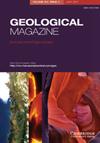中国东北赛马碱性杂岩中K、Sr和Nd同位素解耦:克拉通根和软流圈的相互作用
IF 2
3区 地球科学
Q3 GEOSCIENCES, MULTIDISCIPLINARY
引用次数: 0
摘要
本文报道了华北克拉通赛马霞石正长岩的高精度K同位素、磷灰石U–Pb年龄、全岩元素和Sr–Nd同位素。微量元素和Sr–Nd–Hf–O同位素数据表明源区存在俯冲沉积物,而K同位素组成在–0.54‰至–0.28‰之间,平均值为–0.41±0.06‰,与软流圈的值相同。与之前报道的岛弧熔岩的K同位素组成(-1.55‰至+0.2‰)相比,几乎相同的K同位素成分是低概率事件。尽管地壳污染与Sr–Nd–K同位素数据一致,但我们建议,如果这种相互作用持续很长一段时间,同位素数据也与克拉通根和下伏对流软流圈之间的相互作用相一致。如果Saima碱性岩石的来源岩石圈地幔根的交代作用发生在500 Ma前,则数值模拟成功地再现了观测到的数据。我们的研究表明,由古代俯冲熔体交代的岩石圈地幔中快速扩散组分的同位素组成可以通过长时间的扩散被对流软流圈有效地均匀化。本文章由计算机程序翻译,如有差异,请以英文原文为准。
Isotopic decoupling of K from Sr and Nd in the Saima alkaline complex, NE China: interactions of cratonic roots and asthenosphere
Abstract We report high-precision K isotopes, apatite U–Pb ages, whole-rock elements and Sr–Nd isotopes for the Saima nephelite syenite in the North China Craton. Trace-element and Sr–Nd–Hf–O isotope data indicate the presence of subducting sediments in the source region, while K isotopic compositions show a narrow range between –0.54 ‰ and –0.28 ‰, with an average of –0.41 ± 0.06 ‰, identical to the value of the asthenosphere. The nearly identical K isotopic compositions are low probability events compared with the K isotopic compositions of island arc lavas reported previously (–1.55 ‰ to +0.2 ‰). Although crustal contamination is consistent with the Sr–Nd–K isotopic data, alternatively we propose that the isotopic data also reconcile with the interaction between cratonic roots and the underlying convective asthenosphere, if this interaction is over prolonged periods of time. Numerical simulations successfully reproduced the observed data, if the metasomatism of the lithospheric mantle root, the source of the Saima alkaline rocks, occurred 500 Ma ago. Our study reveals that the isotopic compositions of fast-diffusion components in a lithospheric mantle metasomatized by ancient subducting melts can be effectively homogenized by convective asthenosphere through diffusion over a long time interval.
求助全文
通过发布文献求助,成功后即可免费获取论文全文。
去求助
来源期刊

Geological Magazine
地学-地球科学综合
CiteScore
4.70
自引率
0.00%
发文量
111
审稿时长
3 months
期刊介绍:
Geological Magazine, established in 1864, is one of the oldest and best-known periodicals in earth sciences. It publishes original scientific papers covering the complete spectrum of geological topics, with high quality illustrations. Its worldwide circulation and high production values, combined with Rapid Communications and Book Review sections keep the journal at the forefront of the field.
This journal is included in the Cambridge Journals open access initiative, Cambridge Open Option.
 求助内容:
求助内容: 应助结果提醒方式:
应助结果提醒方式:


